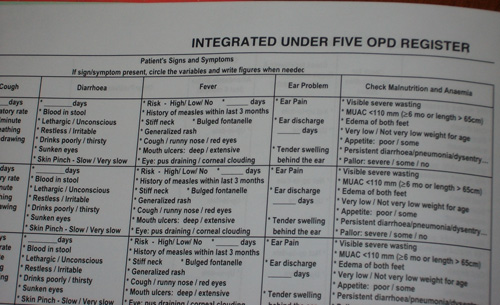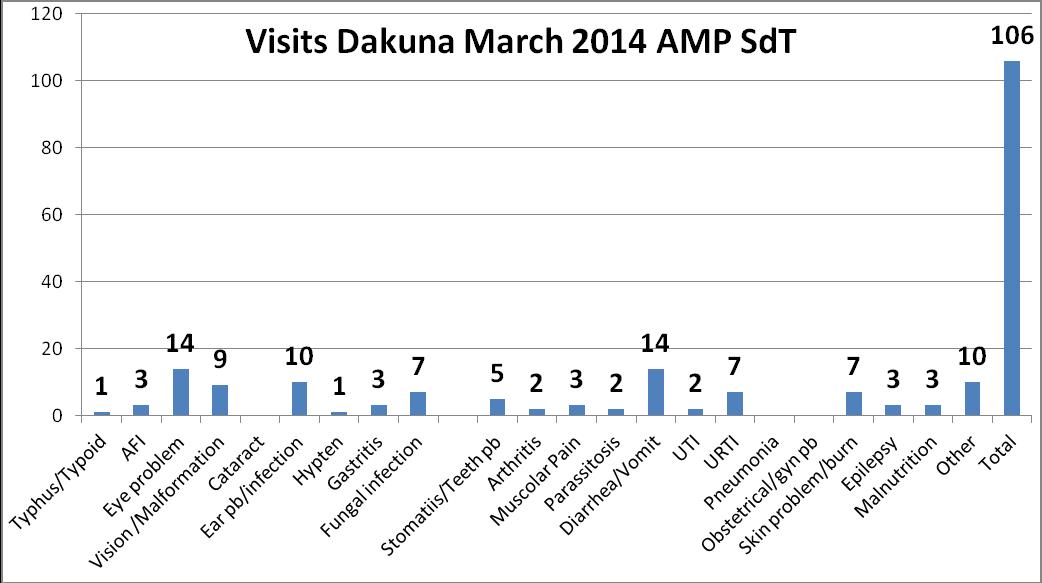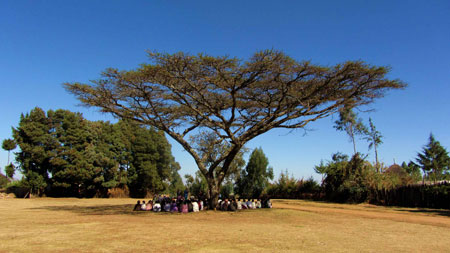Gurage 2013 – 2014
Zizencho and Burat December 2013
Serena Carletti, Franca Di Girolamo January 2014
Shebraber and Dakuna Adriana Formica and Pierangela Rana April 2014
Short report March 2014 Anna Morena Pavan, Stefano del Torso
We visited all 7 Health Clinics (HC) of the ‘ Eparchy of Emdibir and the referral hospital in Attat . The HC are essential to filter the accesses to the Hospital, difficult for distances, lack of transport, and in the rainy season almost impossible for the road conditions .
Each clinic has a delivery room, outpatient clinic, laboratory and drug distribution : there is no ‘ uniformity’ of equipment and material in use, including medications .
The accommodation for doctors / volunteers are acceptable and in some cases good, even if the availability’ of water and electricity is highly variable.
Not all clinics have the ambulance and there are very different settings and organization , equipment , number and qualifications of personnel in particular regarding mother and child approach .
The total number of daily visits varies from 80 to 130 or more ‘ of which at least one third < 10-12 years. In some clinics it is possible to work on Saturdays.
Local schools principals are invited to send children with problems when at the HC there are pediatricians . Our activity can be very varied and challenging, facing very different experiences of the various members of the staff and space is available for all those who are interested .
We discussed with the coordinator of the Gurage activities a project to standardize the minimum levels of mother and child care in the various clinics where it could be necessary to include also training as well as finding funds .
In addition to the current partnership with Engera and hopefully with Meyer Hospital and the Region of Tuscany there are interesting possibilities of additional collaboration with other associations on both medical activities as well as structural interventions in the medium term .
Other meetings
– Archbishop Archbishop Abune Bernaneyesus
– Abba Tekle Mekonen President Ecusta Università Cattolica Addis Ababa
– Monsignor Musie Gebreghiorgis Bishop of Emdibir, Charman Catholic Bishop Conference of Ethiopia
– Abba Fikre Teshome, Activities Coordinator and Assistant Bishop Gurage, Epiarchia of Emdibir
– Embassy of the Order of Malta – Director Walter Panzeri
– Italian School of Addis Ababa Dr. Daniele Castellani Director
– Embassy Italian Pasquale Melloni, Pasquale Farese Program Coordinator, Alessandra Testoni
– Hospital Wolisso Fabio Manenti Arianna (medical director) Silvia (Pediatrician )
– Hospital Attat Sister Rita dr . Toni Pizzecco Doctors AltoAdige
– Dr. Thomas Lanzano , General Hospital Meyer
– Jose Mari a Caldes Pinilla Director, Center for Global Health , Region of Tuscany Meyer Hospital
– Francesco Silenzi ,Giuseppe Indolfi, Engera
Visits Dakuna (4 days) and Maganasse (1 am), Education and Screening Visus



Visits: Maganasse is 15 km away from Dakuna , about 2-300 m lower ( Dakuna 2100 – Maganasse 1900) and therefore is a medium-risk malaria area .
In Dakuna we saw children of all ages and even adults (15 – 80a). In Maganasse we only supported for 1 morning the nurse who sees children up to 5 years using the IMCI register.
Education: HOTV, broncodilatatori e distanziatore, Alimentazione, Approccio al bambino, Patologie etc…
Screening Visus: 2Win for about 80 adult and pediatric patients and staff. Thanks to the presence of Padova Ospitale Ophthalmologist and Optician we provided 1 pair of glasses and 2 others were sent from Italy to children seen at the Dakuna Clinic.
Gurage 2013
Dakuna and Getche Aprile 2013
Sonia Storelli, Constantino Gobbi
Short Report Mauro Mancino e Roberto Corbo Februaio 2013 Zizencho e Burat
Just step off the plane at the airport in Addis Ababa and you realize that you have arrived in Africa.
You’d know right away even if you were an alien seeing the queue that you need to do for the visa , for the strong odor, for the confusion almost a party atmosphere.
The driver is waiting outside. He would wait a whole day: smiling even though we were long overdue.
Procedures to disembark were a bit long, but this is also a sign of the Africans: they know that things happen sooner or later anyway, haste is an invention of us Europeans.
 Start of the journey. The sun is warm but not sultry, gets into the jeep erasing the fatigue of the night spent in the economy seat, we feel strongly that the adventure is beginning to gain momentum.
Start of the journey. The sun is warm but not sultry, gets into the jeep erasing the fatigue of the night spent in the economy seat, we feel strongly that the adventure is beginning to gain momentum.
The traffic noise, the voices of the people, the talk of the driver and recognizing places already seen makes us feel at ease.
A stop for a quick breakfast and then off to the highlands: a run on the ribbon of asphalt with the windows open. Countries and cities follow one another similar but different with their sycamores and people children animals to form a whole . Then begins the track and after a few minutes we realize that it would not be short.
You wanted to Africa? Here it is in its hardness: dust, potholes speed up to our expectations.
We reason with our “home” distances, more or less like going from Pesaro to Bologna but the reality is that it is much more challenging.
Climbing between gullies imagining how rivers will be during the rainy season, the red earth that rises to our passage, the eucalyptus trees that sometimes seem to get inside the windows as if they wanted to come with us.
Nothing stops because our driver must also go back and travel at night here is even more dangerous.
Finally we arrive: in Zizencho we find the beginning of a sunset that takes your breath away.
From all points of view: the beauty of nature but also the loneliness of this Health Center is surrounded by a large enclosure surrounded by a well guarded esplanade at 2,800 meters which is lost until the horizon.
We identify immediately the clinic and the facilities where the next day we begin our work, a small Kinder Garden and the house that would host us.
Sister Sorabhila welcomes us with her sisters and accommodates us in the room in which we will be staying.
A little stunned arrive at the first dinner together.
A little stunned we arrive at the first dinner together. We immediately realize that this time with the Community is the highlight of our day.
The one where we talk about the satisfactions and disappointments, the one where tensions can dissolve and make plans for the next day.
We immediately make it clear that we want to settle, not to be a burden, be useful and we would like to be helped to achieve the purpose.
Sister Sorabhila looks relieved: she looks libeling a person who faces a problem and solves it with simplicity and tenacity. When we tell her about CCWW and its projects, I read in her eyes that he would like to seize the good opportunity
The first night was memorable : at nine o’clock the electric lights are turned off and the lack of moon makes the darkness very dense.
But the sky… the sky that I had only read about as described in the novels of Wilbur Smith has manifested itself throughout his majesty with a number of stars that Roby has described a bit with the knowledge and a bit without much knowledge but I was satisfied all the same.
The lullaby comes from the hyenas in Guraghe, the day is of the men and the night of the hyenas and when you start to hear the howl that comes close you feel safe only indoors.
The work in the clinic is very well organized : the patients belong to a very large area and it has been calculated that around twenty thousand people use the services of the clinic Zizencho.
As they arrive they are received by the acceptance, they have a card with the number of their personal folder. The chart is taken from the shelf and is given into one of three clinics OPD (out patient department).
In each of the three clinics there is a young man qualified Nurse or student.
Every Nurse at the end of the day has seen at least 50 visits and each visit is registered in the chart with the diagnosis and therapy.
The activity is scheduled daily from 8.30 am to 13 and from 14 30 to 17 but one of the nurses in turn is on call after hours. Each patient goes to the pharmacy after visiting the clinic where the updated chart is sent, collects medicines and pays a fee for the service.
In the clinic, there are also a delivery room , an emergency room and a laboratory where tests are done for HIV or for the typhus or typhoid fever but also for diabetes.
Our work starts next to one of the young nurse: at first we looked at the way he visits, we tried to understand what strategies they used to arrive at their conclusions, then slowly we entered into the heart of the work by visiting hilden more comprehensively and thoroughly guiding the nurse to more focused conclusions.
This aspect requires a lot of tact and delicacy because the final responsibility for the decision rests with the nurse and we have never forced them. The synergy that has beendeveloped among us the main satisfaction that we have gathered in this mission.
The diseases we have encountered most frequently were: Typhoid Fever Typhoid , pneumonia, Gatro – enteriti , skin infections, parasitosis, conjunctivitis, Malnutrition, Tuberculosis.
Malaria is not present given the altitude over 2900 metres. Despite the children follow vaccination schedules we have not had the opportunity to participate in this activity.
We have not disdained to visit even adults although we have never been put in a position of having to do it and we treated renal colic, infections, high blood pressure, diabetes, gastritis, and arthro- myalgic pains of all kinds.
In addition to the clinic we have worked to make visits to the children in the schools in the area.
We visited the children in the Kinder Garden and neighboring schools by subjecting them to the test of visual acuity calledHOTV directly providing medical examinations and therapies or by sending to the clinic the most seriously ill.
In addition to the approximately fifty patients a day (adults and children) that we visited in the clinic , we have seen and tested about 308 children in different schools and Zizencho and Arakat.
The second week began with the transfer to Burat where there is a clinic organized like that of Zizencho.
In this case, the context is a bit different because Burat is a real village.
We have been welcomed by the amiable Sister Annie who made us immediately assist to a childbirth.
The curious thing was that after assisting the delivery we have also given baby her ame. Amina was the first small baby under our care.
Sister Sophie is the manager of this clinic: very different from Sister Surabhila shares, however, in an authentic way the same ideals and the same deep endless energy coping with challenging situations that arise in everyday life.
Here we met young guys who do the work of nurse with great dedication and commitment . Do not forget that in addition to working hard during the day, to ensure their survival by cooking meals and solving all the problems of their daily necessities.
Even in Burat the average daily visits areabout fifty per day and the number of school children that have been visited and tested with the HOTV was about two hundred unit.
In Burat we met up with three other Italian volunteerss who are collaborating in the daily activities : anyone with or without any skill can make himself available and gains a lot to take home.
Support the gaze : from the first time I was in Ethiopia the greatest difficulty that I had to overcome was to support the gaze of children, persons, workers who live and work in conditions that compared to the ones I am used to, appear desperate.
Getting used to this challenge was the most difficult task in this experience because our attention is so important for them and they offer much more love and you do not feel worthy.
